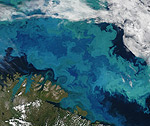This NASA satellite image shows a massive phytoplankton bloom — more than 500 miles long and several hundred miles wide — in the Barents Sea, a frigid body of water located north of Norway and Russia.
The bloom occurred north of the Scandinavian peninsula, an area where multiple ocean current systems merge into the North Cape Current. While it is common for blooms to spread hundreds, or even thousands, of miles across the North Atlantic and Arctic waters — especially in August in the Barents Sea — it is rare to get such a clear view since the sea is covered by clouds most of the summer. The milky blue color suggests the presence of coccolithophores, a microscopic plankton containing white calcium carbonate, which when viewed through ocean water appears bright blue. In the Arctic, the annual spring phytoplankton blooms, triggered by melting sea ice, play a key role in the region’s marine ecology
NASA Satellite Captures Huge Algal Bloom in Barents Sea
More From E360
-
INTERVIEW
On Controlling Fire, New Lessons from a Deep Indigenous Past
-
Solutions
Paying the People: Liberia’s Novel Plan to Save Its Forests
-
OPINION
Forest Service Plan Threatens the Heart of an Alaskan Wilderness
-
INTERVIEW
Pakistan’s Solar Revolution Is Bringing Power to the People
-
Food & Agriculture
In Uganda, Deadly Landslides Force an Agricultural Reckoning
-
Energy
Why U.S. Geothermal May Advance, Despite Political Headwinds
-
Food & Agriculture
In War Zones, a Race to Save Key Seeds Needed to Feed the World
-
Climate
Lightning Strikes the Arctic: What Will It Mean for the Far North?
-
RIVERS
A Win for Farmers and Tribes Brings New Hope to the Klamath
-
Solutions
Deconstructing Buildings: The Quest for New Life for Old Wood
-
NATURAL DEFENSES
How Restored Wetlands Can Protect Europe from Russian Invasion
-
Solutions
Birds vs. Wind Turbines: New Research Aims to Prevent Deaths
